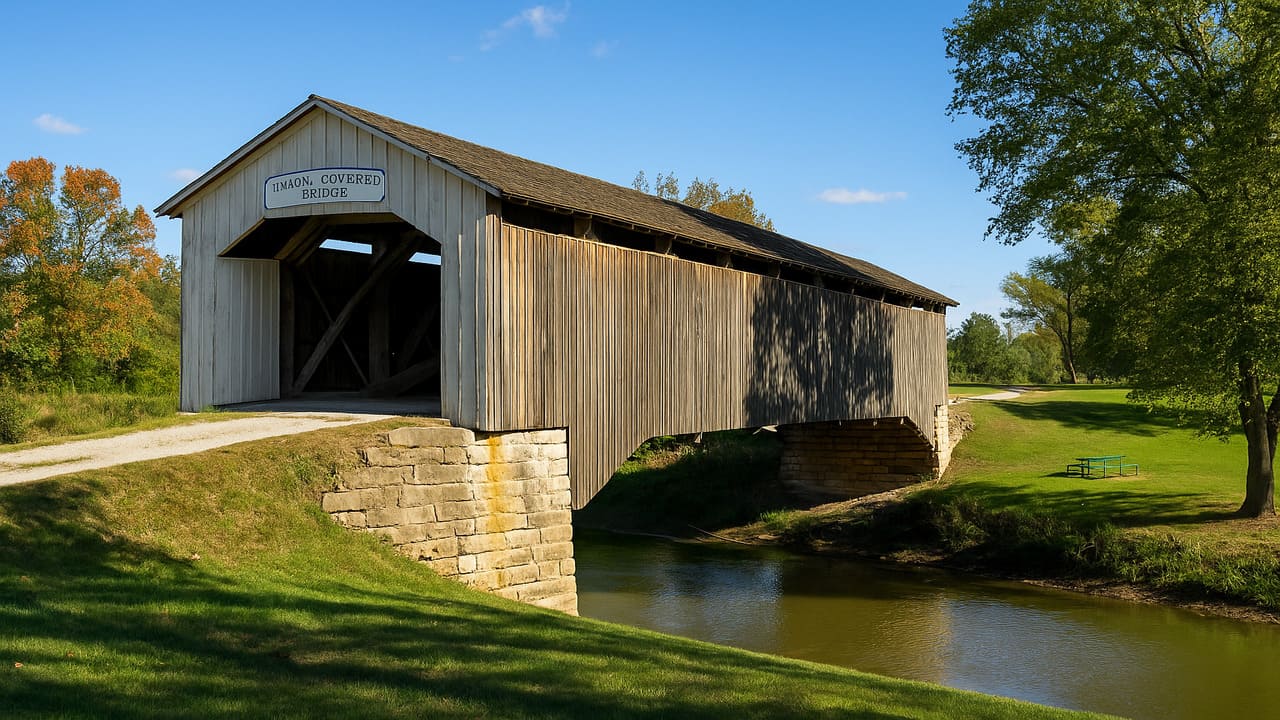
Visit MarkTwain Lake – Union Covered Bridge Historic Site stands as a silent witness to a bygone era. Built in 1871, it is one of only four surviving covered bridges in the entire state, and the only one remaining in northern Missouri. With its classic Burr-arch truss design, the Union Covered Bridge has long served as more than a transportation structure it’s a symbol of Missouri’s early engineering ingenuity and rural charm.
Originally constructed to facilitate travel across the Elk Fork of the Salt River, the bridge provided a vital connection for local farmers, traders, and travelers. Its covered design, practical in both structure and symbolism, protected the wooden deck from rain and snow, thereby preserving its longevity. Today, as the modern world races forward, Union Covered Bridge remains a static but powerful relic of an age defined by slower movement and closer community ties.
The structure of the Union Covered Bridge is more than just functional it is a testament to 19th-century craftsmanship. Built by Joseph C. Elliott, the bridge spans 120 feet in length and utilizes the Burr-arch truss system, a hybrid design combining a sturdy arch with a multiple kingpost truss. This method was popular at the time for its ability to support substantial weight while withstanding harsh weather conditions.
Every wooden beam, joint, and nail reflects a time when builders relied on skill and intuition rather than computer models and automated tools. The bridge’s weathered timbers and hand-hewn appearance give it an authentic feel that modern replicas struggle to capture. Although the bridge was temporarily closed in the early 21st century for restoration, those efforts remained faithful to the original design, preserving both its integrity and historical accuracy.
The interior of the bridge evokes a sense of rustic simplicity. With filtered sunlight peeking through the wooden slats and casting shadows across the worn floorboards, the atmosphere is perfect for photography enthusiasts or anyone seeking a moment of peaceful reflection.
Read More : Kanye West Concert in South Korea Canceled After Release of Song Heil Hitler
More than a historical artifact, Union Covered Bridge Historic Site also serves as a peaceful recreational area. Surrounded by lush vegetation and set against the gentle curve of the Salt River, the site invites visitors to slow down and enjoy nature’s quieter moments. It’s not uncommon to see families laying out picnic blankets under the shade of nearby trees, or couples strolling hand in hand, stopping occasionally to admire the bridge from various angles.
The natural setting changes with the seasons, offering something unique year-round. In spring, wildflowers bloom across the grounds, while autumn brings a rich palette of red and gold foliage that frames the bridge in warm hues. In winter, a light dusting of snow turns the site into a postcard-worthy landscape, perfect for contemplative walks or amateur photography sessions.
Birdsong, the distant hum of water, and the occasional creak of the bridge underfoot all contribute to an experience that feels both grounded and timeless. This is not a place for crowds or loud activities it’s a retreat for those looking to connect with history and nature in a meaningful way.
While the bridge itself is the focal point, interpretive signage throughout the site adds context to the experience. These panels detail the history of the structure, its architectural significance, and its role in the development of the surrounding region. They help visitors understand why such bridges were built, how they were used, and what they meant to the people who relied on them.
Local heritage groups often use the site for educational events, living history demonstrations, and historical walking tours. These activities bridge the gap quite literally between generations, offering young visitors a chance to engage with history in a tactile, immersive way. Unlike a museum exhibit behind glass, the Union Covered Bridge invites exploration and interaction, encouraging a deeper appreciation of Missouri’s cultural heritage.
Community efforts to preserve and promote the site reflect a broader recognition of the importance of maintaining historical landmarks. Each act of care, from replacing rotting timbers to maintaining the surrounding parkland, is a quiet tribute to those who built and used the bridge over a century ago.
Read More : Lick Creek Trail: A Serene Journey Through Nature in Mark Twain State Park
For those planning a longer visit, the Union Covered Bridge Historic Site pairs well with other cultural attractions in Monroe County. A short drive away lies Mark Twain Birthplace State Historic Site, located in the small town of Florida, Missouri. Here, visitors can learn about the formative years of one of America’s most beloved writers and see the cabin where Samuel Clemens was born.
Another worthwhile destination is Paris, Missouri, where the Monroe County Courthouse and local shops offer a glimpse into small-town life with a dash of historical flair. For nature lovers, Mark Twain Lake provides ample opportunities for boating, fishing, and hiking, making it a perfect complement to the quiet beauty of the covered bridge.
Together, these sites form a thematic loop of history, literature, and natural beauty that speaks to the enduring spirit of Missouri. Whether you’re a first-time traveler or a returning visitor, Monroe County holds more than meets the eye and Union Covered Bridge is the perfect place to begin that journey.